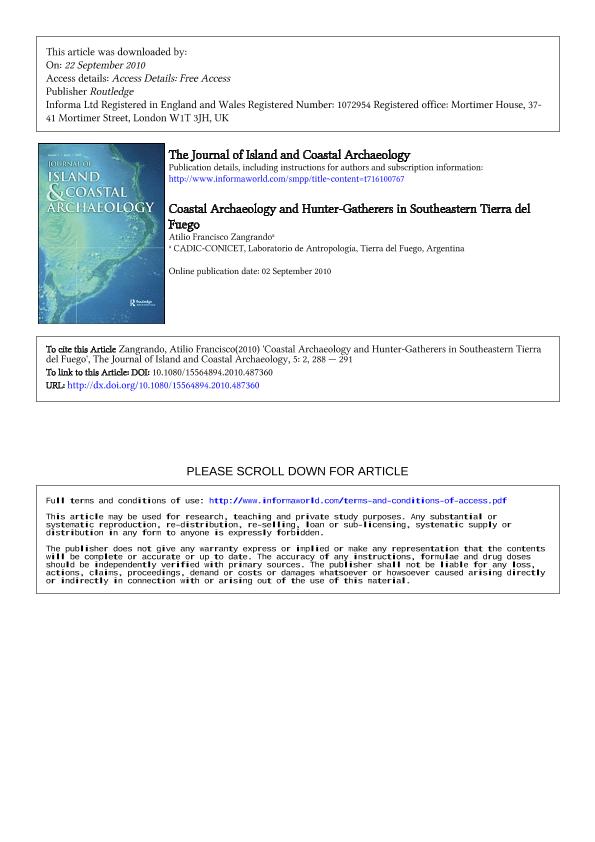Mostrar el registro sencillo del ítem
dc.contributor.author
Zangrando, Atilio Francisco Javier

dc.date.available
2017-02-08T20:53:51Z
dc.date.issued
2010-09
dc.identifier.citation
Zangrando, Atilio Francisco Javier; Coastal Archaeology and Hunter-Gatherers in the Southeastern Tierra del Fuego; Taylor & Francis; Journal of Island and Coastal Archaeology; 5; 2; 9-2010; 288-291
dc.identifier.issn
1556-4894
dc.identifier.uri
http://hdl.handle.net/11336/12737
dc.description.abstract
The southeastern coasts of Tierra del Fuego are archaeologically multifaceted landscapes. This may be due to the fact that these settings served as zones of interactions between biologically, culturally, and linguistically distinct co-resident groups. Abundant ethnographic information indicates that the southeastern coast of Tierra del Fuego was inhabited by both maritime (Yamana ´ ) and terrestrial (Selk’nam and Haush) populations of hunter-gatherers (Bridges 1886; Gusinde 1937; Hyades and Deniker 1891; Lothrop 1928). Although these populations maintained exchange and marriage relationships, their lifestyles were markedly different (Gusinde 1937). This population pattern is well known in historic times, but the timing and structure are still unclear for prehistoric times. It is only recently that this subject began to be assessedin the region (Zangrando et al. 2009). To improve our knowledge on the use of coastal environments and social interaction by different groups of hunter-gatherers of Tierra del Fuego, I started with an archaeological project in Moat. This is a region located in the central section of the south coast of this island, and includes all of the homonymous river basin, and the coastline extending from the mouth of Cambaceres River to Sloggett Bay (Figure 1). This study area covers approximately 1,000 km2. No archaeological research was previously developed in this region. The first goals of this project are to analyze the spatial and temporal distribution of sites, and to explore the composition of archaeological assemblages to assess the use of space and resources by hunter-gatherer populations. This research will assist in identifying contrasting subsistence and technological strategies of those groups at the same or at different points in time, and will provide clues about past habitat use and competitive/cooperative social relationships associated with resource procurement.
dc.format
application/pdf
dc.language.iso
eng
dc.publisher
Taylor & Francis

dc.rights
info:eu-repo/semantics/openAccess
dc.rights.uri
https://creativecommons.org/licenses/by-nc-sa/2.5/ar/
dc.subject
Moat
dc.subject
Hunter-Gatherers
dc.subject
Spatial Tendencies
dc.subject.classification
Arqueología

dc.subject.classification
Historia y Arqueología

dc.subject.classification
HUMANIDADES

dc.title
Coastal Archaeology and Hunter-Gatherers in the Southeastern Tierra del Fuego
dc.type
info:eu-repo/semantics/article
dc.type
info:ar-repo/semantics/artículo
dc.type
info:eu-repo/semantics/publishedVersion
dc.date.updated
2017-02-07T18:02:27Z
dc.journal.volume
5
dc.journal.number
2
dc.journal.pagination
288-291
dc.journal.pais
Reino Unido

dc.journal.ciudad
Londres
dc.description.fil
Fil: Zangrando, Atilio Francisco Javier. Consejo Nacional de Investigaciones Científicas y Técnicas. Centro Austral de Investigaciones Científicas; Argentina
dc.journal.title
Journal of Island and Coastal Archaeology
dc.relation.alternativeid
info:eu-repo/semantics/altIdentifier/url/http://www.tandfonline.com/doi/full/10.1080/15564894.2010.487360
dc.relation.alternativeid
info:eu-repo/semantics/altIdentifier/doi/http://dx.doi.org/10.1080/15564894.2010.487360
Archivos asociados
